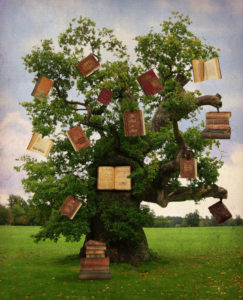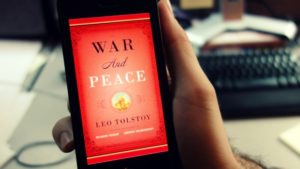Readers and writers alike often debate the merits of eBooks versus traditional print publications. Though both sides offer valid support for their claims, this contentious argument is unlikely to end any time soon. Regardless of your position on this issue, one thing remains clear: eBooks are here to stay. Read on to discover 10 fascinating facts about eBooks, their history, and their forecasted future.
1.) One impressive precursor to the modern-day eReader  was developed by a Spanish woman, Ángela Ruiz Robles, in 1949. Robles sought to reduce the load of books carried by her students. Her invention, dubbed the “Mechanical Encyclopedia,” was operated by using compressed air. Reels of text and images were threaded around spindles within the reader. Other features of the device included a magnifying glass, a light for reading in the dark, and audio commentary. Though technological and financial limitations prevented Robles’ eReader from becoming a reality, it is remembered today as an important innovation in the history of eBooks.
was developed by a Spanish woman, Ángela Ruiz Robles, in 1949. Robles sought to reduce the load of books carried by her students. Her invention, dubbed the “Mechanical Encyclopedia,” was operated by using compressed air. Reels of text and images were threaded around spindles within the reader. Other features of the device included a magnifying glass, a light for reading in the dark, and audio commentary. Though technological and financial limitations prevented Robles’ eReader from becoming a reality, it is remembered today as an important innovation in the history of eBooks.
2.) As of 2015, the “digital apocalypse” has yet to arrive. Data from the Association of American Publishers, which studied data from over 1,200 publishers, noted that eBook sales fell roughly 10% in the first half of 2015. Instead of overtaking the market, digital books continue to hold roughly 20% of the market share, much as in prior years. Similar trends have been seen in other major global markets, including Germany and the U.K., continuing into 2016. These statistics hardly spell doom for eBook publishers, however. Book sales remain steady for many. Indeed, most studies neglect to report on the sales of independent publishers and self-published writers. Catering to both digital- and print-loving customers seems to be the best option for writers in 2016.
3.) In June of 2016, Apple agreed to pay out $400 million in a settlement regarding eBooks. The company was found guilty of conspiring with five major U.S. publishers to drive up eBook prices. Customers who bought eBooks from Amazon, Apple, Barnes & Noble and Kobo between April 2010 and May 2012 may be eligible for refunds from these vendors. Most individuals have been automatically refunded part of the cost of these purchases ($6.93 for New York Times bestsellers and $1.57 for other books).
 4.) Though the exact numbers are up for debate, multiple studies have shown that reading eBooks is better for the environment than plowing through stacks of printed materials. Though the production of the eBook reader itself is not particularly “green,” studies suggest that reading 20-40 eBooks per year is enough to spare a tree. As eBooks become more popular, it is possible that the staggering number of trees used to produce books (30 million in the United States each year) may be lowered. In general, eBooks offer a more eco-friendly alternative to paper publications.
4.) Though the exact numbers are up for debate, multiple studies have shown that reading eBooks is better for the environment than plowing through stacks of printed materials. Though the production of the eBook reader itself is not particularly “green,” studies suggest that reading 20-40 eBooks per year is enough to spare a tree. As eBooks become more popular, it is possible that the staggering number of trees used to produce books (30 million in the United States each year) may be lowered. In general, eBooks offer a more eco-friendly alternative to paper publications.
5.) As of August 2015, the top-selling Kindle eBooks of all time included: Fifty Shades of Grey, Fifty Shades Darker, Gone Girl, Fifty Shades Freed, The Hundred-Year-Old Man Who Climbed Out of the Window and Disappeared, Life of Pi, The Girl with the Dragon Tattoo, Twelve Years a Slave, and Thursdays in the Park.
6.) Smashwords, a popular self-serve publishing firm, has analyzed many eBook figures and trends. One interesting discovery was the ratio of sales amongst popular titles. A #1 bestseller, for instance, was selling more than twice the number of copies sold by a #5 ranked book. Though a book at place #500 is clearly a success, this top-seller is likely reaching only 3% of the sales achieved by the #1 bestseller. What does all of this data mean? In short, the very top authors are achieving massive success. Reaching the peak of the bestseller list should be among every author’s goals.
7.) Readers overwhelmingly prefer longer publications over shorter ones. In another Smashwords study, the publishing service learned that their top 100 bestsellers averaged a whopping 115,000 words, or roughly 460 pages. The study showed a strong correlation between eBook length and sales. Writers should avoid filling their pieces with unnecessary content, however. Authors should, on the other hand, opt for focusing on longer works rather than serialized stories or breezy novellas.
8.) As of May 2016, eBooks published by the “Big Five” publishing houses (Hachette, HarperCollins, Macmillan, Penguin Random House, and Simon & Schuster) have fallen in price. In many cases, popular titles were more than $1.00 cheaper than their January prices. The average price of Big Five titles fell from $10.31 in January to $8.67 in May. Prices have likely fallen as a result of competitors’ prices; independent publishers and self-published authors are increasingly releasing titles priced at $3.00 or less.
 9.) Tablets, such as the Kindle Fire and iPad, are currently the most popular devices for reading eBooks. Individuals who read their eBooks primarily on tablets reached 41% in 2015, up from 30% in 2012. Most publishers, however, are beginning to focus on smartphones and their viability as eReaders. In late 2014, more than 50% of eBook readers admitted to reading at least some of their books on their phone, a sharp increase over 2012 statistics. A full 14% of eBook readers primarily consume literature on their phones. In contrast, the number of individuals reading on tablets and dedicated eReaders has dropped in recent years.
9.) Tablets, such as the Kindle Fire and iPad, are currently the most popular devices for reading eBooks. Individuals who read their eBooks primarily on tablets reached 41% in 2015, up from 30% in 2012. Most publishers, however, are beginning to focus on smartphones and their viability as eReaders. In late 2014, more than 50% of eBook readers admitted to reading at least some of their books on their phone, a sharp increase over 2012 statistics. A full 14% of eBook readers primarily consume literature on their phones. In contrast, the number of individuals reading on tablets and dedicated eReaders has dropped in recent years.
10.) A 2015 study of Canadian eBook publishers and buyers discovered some interesting facts about the current state of eBook sales. 17% of those polled had purchased an eBook in the past month. 31% of customers bought only eBooks whereas 61% of customers bought a mix of print and digital titles. A whopping 93% of publishers had begun selling eBooks, with nearly 50% offering a majority of their titles in a digital format. Perhaps most interestingly, more than 1 in 4 of the surveyed publishers bundled digital copies of books with print editions.
The world of eBooks is constantly shifting and changing. What will the publishing world look like five years from now? That remains to be seen!
This post was written by Kara Kitze, Gold Orchid Publishing’s Blog and Social Media Assistant.
Sources:
http://www.livescience.com/26728-first-e-reader.html
https://en.wikipedia.org/wiki/%C3%81ngela_Ruiz_Robles
http://www.nytimes.com/2015/09/23/business/media/the-plot-twist-e-book-sales-slip-and-print-is-far-from-dead.html
http://publishingperspectives.com/2016/06/ebook-sales-germany-revenue/
http://www.wsj.com/articles/apple-pays-back-e-book-buyers-following-settlement-1466541963
http://www.telegraph.co.uk/journalists/geoffrey-lean/8234044/How-many-e-books-to-spare-a-tree.html
http://www.greenpressinitiative.org/about/bookSector.htm
http://epublishersweekly.blogspot.de/2009/09/ebooks-save-millions-of-trees-10-ideas.html
http://www.techradar.com/news/portable-devices/amazon-reveals-best-selling-kindle-books-of-all-time-1301101
http://blog.smashwords.com/2013/05/new-smashwords-survey-helps-authors.html
http://authorearnings.com/big-five-may-2016-ebook-pricing/
http://www.wsj.com/articles/the-rise-of-phone-reading-1439398395
http://www.booknetcanada.ca/blog/2015/9/17/read-an-ebook-day-celebrate-with-5-facts-about-ebooks-in-canada
